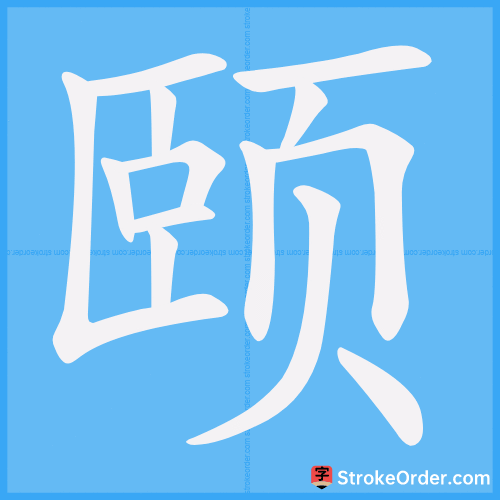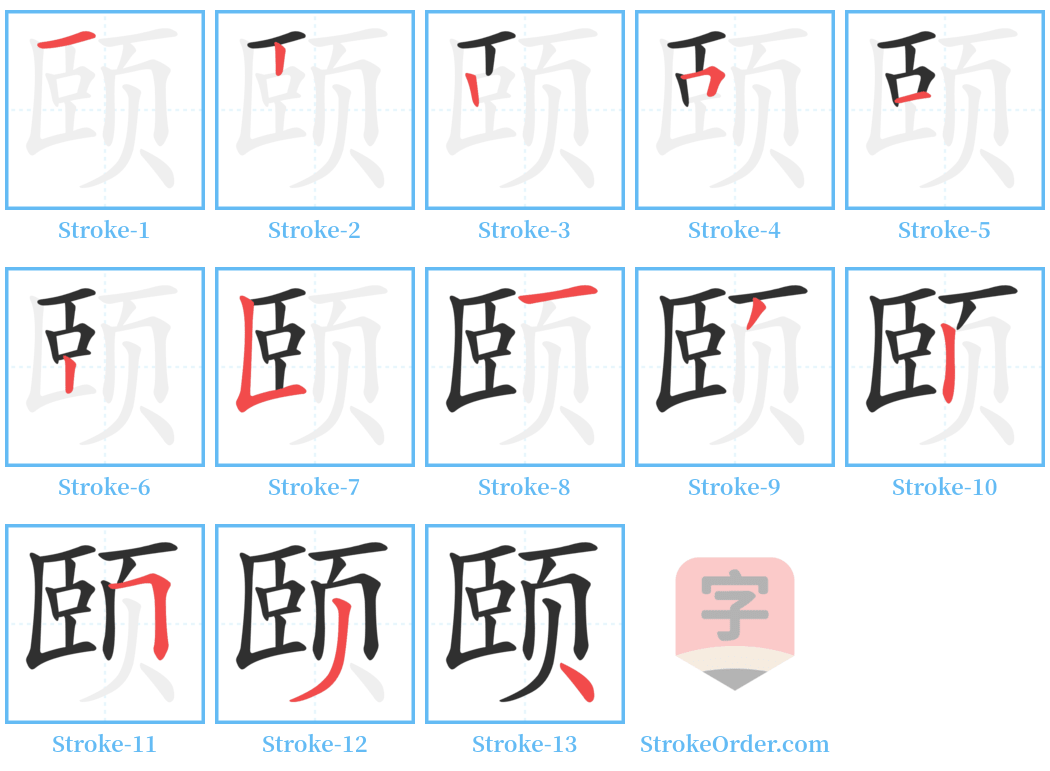颐 Stroke Order
Animated Stroke Order of 颐

Stroke Order Diagrams for 颐

Step-by-Step Handwriting Guide for 颐

Learn to Write Chinese Characters with Video Tutorials
Watch the video of writing the Chinese character "颐", learn the correct stroke order (笔顺) of the character "颐", and master the standard way of writing the character "颐".
Free Printable Handwriting Practice with Stroke Order: 颐
Printable Writing Practice Worksheet of "颐" in Portrait Orientation (Tian Zi Ge)

Printable Writing Practice Worksheet of "颐" in Landscape Orientation (Tian Zi Ge)

Information of 颐
Pinyin
yí
Radical
页
Strokes
13 strokes
Usage
★★★★
Definition
cheeks / nourish
颐 (yí)
1. 面颊,腮。
- Cheeks, jaw; Example: 支颐 (supporting the jaw).
2. 休养,保养。
- Rest, maintenance; Example: 颐神 (keep the spirit); 颐养 (take care of oneself).
3. 文言助词,无义。
- A classical Chinese particle with no meaning; Example: “夥颐!涉之为王沈沈者” (an expression in classical text).
颐 (yí)
名
(形声。From 页 (xié), with the phonetic component 臣 (yí). The character represents the lower jaw.)
- Original meaning: the lower jaw.
颐 (yí)
动
- 保养 (keep fit; take care of oneself).
引:
1. 《方言十》: 颐 is also known as 颌 (jaw).
2. 《释名》: 颐 is referred to as rear wheel, tooth wheel, or cheek wheel.
3. 《春秋元命苞》: 后稷岐颐自求 (a classical reference).
4. 《礼记·玉藻》: 端行颐霤如矢 (a classical reference).
5. 《庄子·天地》: 手指颐指 (a classical reference).
6. 《汉书·东方朔传》: 擢项颐 (a classical reference).
7. 《易·噬嗑》: Interpretation saying "the content of 颐 is called 噬嗑" (a classical reference).
8. 《西游记》: 大耳横颐方面相,肩查腹满身躯胖 (a classical reference).
9. 《新唐书》: 方额广颐 (a classical reference).
例:
- 颐腮 (the skull); 颐脱 (dislocated jaw); 颐溜 (bowing down with the chin extending horizontally, showing respect).
颐 (yí)
动
- 保养 (keep fit; take care of oneself).
引:
1. 《易·序卦》: 颐者,养也 (养 means to nurture).
2. 《礼记·曲礼》: 百年曰期颐 (a reference to longevity).
3. 唐· 韩愈《闵己赋》:恶饮食乎陋巷兮,亦足以颐神而保年 (a literary quote about diet and preserving life).
例:
- 颐志 (nurture ambitions); 颐育 (cultivate); 颐神 (preserve the spirit); 颐爱 (cherish); 颐贤 (nurture talent); 颐养精神 (preserve vitality); 颐身 (maintain physical and mental health); 颐年 (extend life); 颐老 (care for the elderly); 颐养天年 (evoke longevity); 颐神养性 (nurture mental vitality).
lit. to order people by pointing the chin (idiom); to signal orders by facial gesture / arrogant and bossy
Input Method for 颐
Pinyin
yi2
Wubi
ahkm
Cangjie
slmbo
Zhengma
hgo
Four Corner
71782
Unicode
U+9890
Same Pronunciation Characters